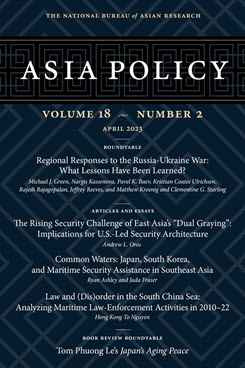Article in Asia Policy 18.2
The Rising Security Challenge of East Asia’s “Dual Graying”
Implications for U.S.-Led Security Architecture in the Indo-Pacific
This article explains the impact of “dual graying”—the concurrent phenomena of rapid population aging and the proliferation of gray-zone conflicts—on the security planning and postures of Northeast Asian states and considers the implications of these trends in the broader context of Indo-Pacific demographics.
EXECUTIVE SUMMARY
MAIN ARGUMENT
The major Northeast Asian powers (China, Japan, South Korea, and Taiwan) as well as Russia are at the leading edge of one of the most consequential challenges of the 21st century: the rapid aging of their populations at a rate unprecedented in human history that is resulting in a shrinkage of their total population sizes. In addition to the graying of their populations, these powers face a range of new “gray” conflicts—interactions residing somewhere between war and peace—that exacerbate long-standing military concerns. Contrary to predictions that rapid aging will diminish the likelihood of interstate war, security tensions are rising among graying rivals in this region of the world, and states are increasing both military spending and military development. This “dual graying” underscores the need for new approaches to the U.S. network of regional security partners.
POLICY IMPLICATIONS
- The rapid aging among regional powers does not so far suggest that an “aging peace” is likely to develop; rather, tensions are increasing over old and new areas of conflict.
- The escalation of regional gray-zone conflicts is taxing U.S. allies and partners with graying and shrinking populations. Demographic changes in several of these major partners may necessitate a re-examination of roles and commitments within the U.S. alliance network.
- Innovations in military and civilian technologies may eventually offset many of the challenges resulting from shrinking and rapidly aging populations, but in the meantime growing labor shortages will force many militaries to seek to adapt in other ways to maintain robust force postures.
- In the wider Indo-Pacific, differential aging and population growth among major security actors suggests a growing role for several middle-power states (such as India, Indonesia, the Philippines, and Vietnam) that may benefit from a “demographic dividend” over the next several decades.
Andrew L. Oros is Professor of Political Science and Director of International Studies at Washington College in Chestertown, Maryland (United States).
About Asia Policy
Asia Policy is a peer-reviewed scholarly journal presenting policy-relevant academic research on the Asia-Pacific that draws clear and concise conclusions useful to today’s policymakers. Asia Policy is published quarterly in January, April, July, and October and accepts submissions on a rolling basis. Learn more


